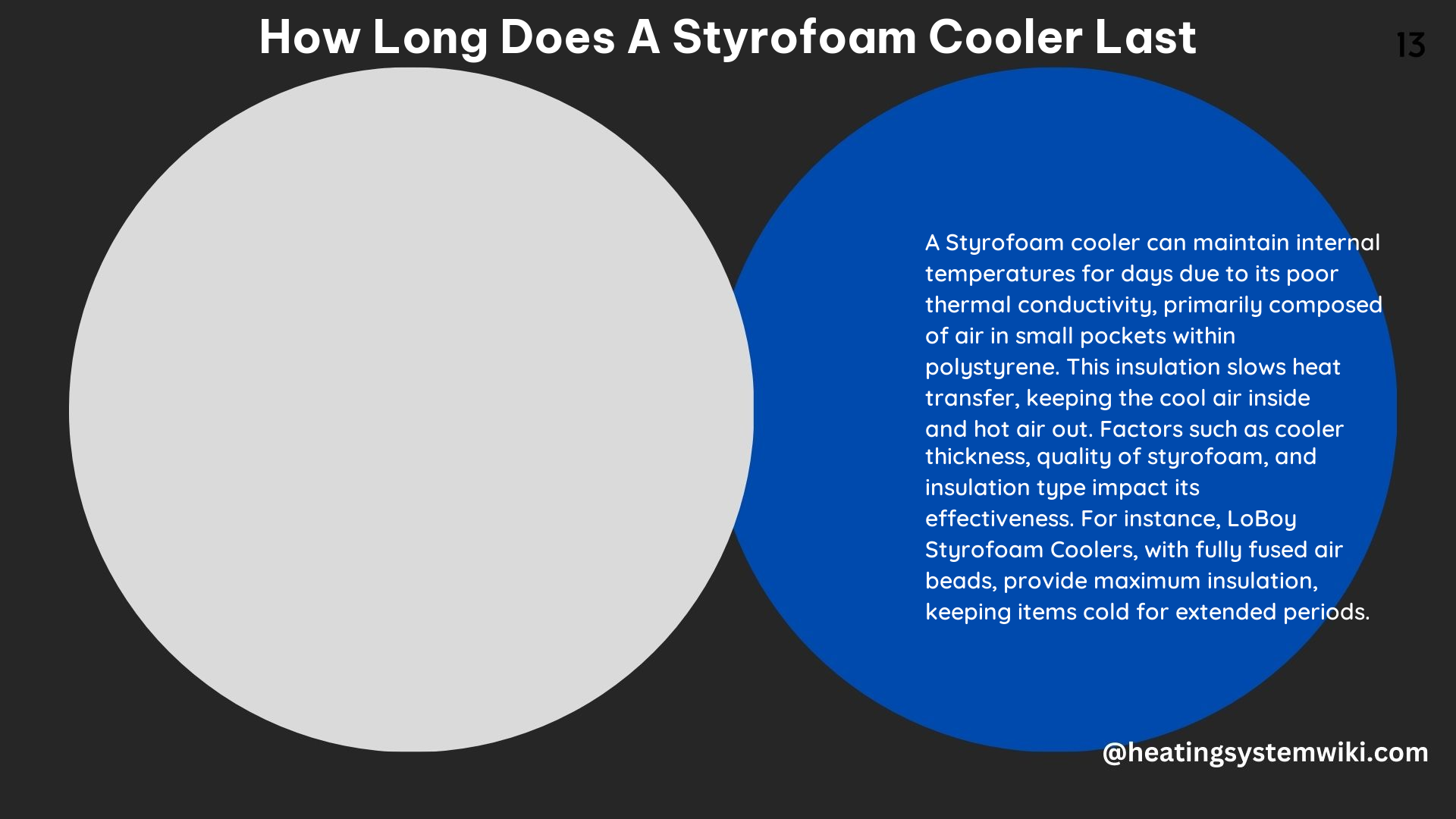A Styrofoam cooler, also known as an expanded polystyrene (EPS) cooler, is a popular choice for keeping food and beverages cold during outdoor activities, picnics, and camping trips. These coolers are lightweight, affordable, and effective at insulating the contents from the surrounding environment. However, the question of how long a Styrofoam cooler can maintain its cooling capabilities is a common concern for many users.
Factors Affecting the Lifespan of a Styrofoam Cooler
The longevity of a Styrofoam cooler is influenced by several key factors, including:
-
Cooler Size and Thickness: The size and thickness of the Styrofoam walls play a crucial role in the cooler’s insulation properties. Larger coolers with thicker walls generally have better insulation and can maintain cold temperatures for longer periods.
-
Insulation Quality: The quality of the Styrofoam insulation used in the cooler’s construction is a significant factor. High-quality, fully fused Styrofoam with a higher density provides superior insulation compared to lower-quality, loosely packed Styrofoam.
-
External Temperature: The ambient temperature surrounding the cooler has a direct impact on its performance. Coolers will maintain cold temperatures for longer in cooler environments, while warmer temperatures will cause the ice or cooling elements to melt more quickly.
-
Frequency of Opening: Each time the cooler is opened, warm air enters, and cold air escapes, accelerating the melting of the ice or cooling elements. Minimizing the number of times the cooler is opened can help extend its cooling capabilities.
-
Preparation and Maintenance: Proper preparation, such as pre-chilling the cooler and its contents, and maintenance, like keeping the cooler clean and dry, can significantly improve its performance and longevity.
Average Lifespan of a Styrofoam Cooler

On average, a standard Styrofoam cooler can keep ice for 1 to 3 days, depending on the factors mentioned above. However, with proper preparation and maintenance, the lifespan of a Styrofoam cooler can be extended.
High-Quality Styrofoam Coolers
High-quality Styrofoam coolers, such as those manufactured by LoBoy, are designed to provide superior insulation and longer-lasting cooling performance. These coolers are constructed with thicker walls and use a specialized Styrofoam formulation that is fully fused, creating a denser and more effective insulation barrier.
According to LoBoy, their Styrofoam coolers can keep ice for up to 5 days or more, depending on the size and external conditions. This extended lifespan is achieved through the following design features:
-
Thicker Walls: LoBoy coolers feature walls that are up to 1.5 inches thick, providing superior insulation compared to standard Styrofoam coolers with thinner walls.
-
Fully Fused Styrofoam: The Styrofoam used in LoBoy coolers is fully fused, creating a denser and more effective insulation barrier that traps cold air inside and keeps heat out.
-
Specialized Foam Formulation: LoBoy uses a proprietary Styrofoam formulation that is optimized for thermal insulation, further enhancing the cooler’s ability to maintain cold temperatures.
-
Airtight Seal: LoBoy coolers are designed with an airtight seal, which helps prevent warm air from entering and cold air from escaping, reducing the rate of ice melt.
Maximizing the Lifespan of a Styrofoam Cooler
To get the most out of your Styrofoam cooler and extend its cooling capabilities, follow these tips:
-
Pre-Chill the Cooler: Before loading the cooler with ice and contents, pre-chill the empty cooler by placing it in a cool, shaded area or in the refrigerator. This helps reduce the amount of heat the cooler has to absorb when filled.
-
Use Large Ice Blocks: Opt for large blocks of ice instead of small cubes. Larger blocks melt more slowly, maintaining a colder temperature for a longer period.
-
Fill the Cooler Completely: Minimize the amount of air inside the cooler by filling it to capacity. The less air, the slower the ice will melt.
-
Keep the Cooler in the Shade: Place the cooler in a shaded area, such as under a tree or canopy, to reduce the impact of direct sunlight and heat.
-
Cover the Cooler: Drape a wet towel or blanket over the cooler to help keep it cool through evaporative cooling.
-
Limit Openings: Avoid opening the cooler frequently, as each opening allows warm air to enter and cold air to escape, accelerating the melting process.
-
Consider Alternatives to Ice: Use gel packs or frozen water bottles instead of traditional ice. These alternatives can last longer and are less messy when melted.
By following these tips and considering the factors that influence a Styrofoam cooler’s lifespan, you can maximize the cooling performance and extend the usable life of your Styrofoam cooler.
Conclusion
Styrofoam coolers can be a practical and cost-effective solution for keeping food and beverages cold during outdoor activities. While the average lifespan of a standard Styrofoam cooler is 1 to 3 days, high-quality models, such as those from LoBoy, can maintain cold temperatures for up to 5 days or more with proper preparation and maintenance.
By understanding the key factors that affect a Styrofoam cooler’s performance and following the tips outlined in this guide, you can ensure your Styrofoam cooler provides reliable and long-lasting cooling capabilities for your next adventure.
